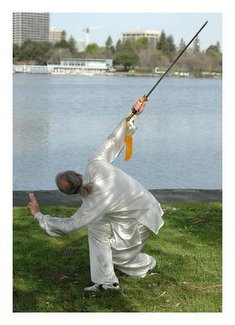Cross-posted at God Is For Suckers!
I'm going to kill two birds with one stone on this one.
One of the major claims in Islam, is how eerily it corresponds with modern science as we know it today.
This site makes a number of extravagant claims, which would appear to the untrained eye to be 'miracles', but which come apart under a small amount of investigation.
First up:
He has created the Heavens and the Earth for Truth. He wraps the night up in the day, and wraps the day up in the night. (Qur'an, 39:5)
In the Qur'an, the words used for describing the universe are quite remarkable. The Arabic word which is translated as "to wrap" in the above verse is "takwir." In English, it means "to make one thing lap over another, folded up as a garment that is laid away." For instance, in Arabic dictionaries this word is used for the action of wrapping one thing around another, in the way that a turban is put on. The information given in the verse about the day and the night wrapping each other up includes accurate information about the shape of the world. This can be true only if the Earth is round. This means that in the Qur'an, which was revealed in the 7th century, the roundness of the world was hinted at.
However, it should be remembered that the understanding of astronomy of the time perceived the world differently. It was then thought that the world was a flat plane and all scientific calculations and explanations were based on this belief. However, the Glorious Qur'an has employed the most definitive words when it came to describing the universe. These facts, which we could only correctly fathom in our century, have been in the Qur'an for a vast length of time.
And then,
It is He Who created everything on the earth for you and then directed His attention up to heaven and arranged it into seven regular heavens. He has knowledge of all things. (Qur'an, 2:29)
Then He turned to heaven when it was smoke. In two days He determined them as seven heavens and revealed, in every heaven, its own mandate. (Qur'an, 41:11-12)
Deflated, two minutes flat.
The Wiki entry not only says this about a spherical earth,
"The concept of a spherical Earth was espoused by Pythagoras apparently on aesthetic grounds, as he also held all other celestial bodies to be spherical. It replaced earlier beliefs in a flat Earth: In early Mesopotamian thought, the world was portrayed as a flat disk floating in the ocean, and this forms the premise for early Greek maps like those of Anaximander and Hecataeus of Miletus."
But also puts the lie to the 'original' claim of the 'seven firmaments', thusly:
"Other speculations as to the shape of Earth include a seven-layered ziggurat or cosmic mountain, alluded to in the Avesta and ancient Persian writings (see seven climes). In fact, the Earth is reasonably well-approximated by an oblate spheroid."
(The Avesta, for those of you interested, are the sacred texts of Zoroaster, and has been dated linguistically at about 1000 BCE, but the written format is dated Second CE).
And, for the icing on the cake,
"Yajnavalkya
Yajnavalkya (c. 9th–8th century BCE) recognized that the Earth is spherical in his astronomical text Shatapatha Brahmana. This is also recognized in another Vedic Sanskrit text Aitareya Brahmana composed around the same time, and in a later Sanskrit commentary Vishnu Purana.
Pythagoras
Pythagoras (b. 570 BCE) found harmony in the universe and sought to explain it. He reasoned that Earth and the other planets must be spheres, since the most harmonious geometric form was a circle.
Plato
Plato (427 BCE - 347 BCE) travelled to southern Italy to study Pythagorean mathematics. When he returned to Athens and established his school, Plato also taught his students that Earth was a sphere. If man could soar high above the clouds, Earth would resemble "a ball made of twelve pieces of leather, variegated, a patchwork of colours."
Aristotle
Aristotle (384 BCE - 322 BCE) was Plato's prize student and "the mind of the school." Aristotle observed "there are stars seen in Egypt and [...] Cyprus which are not seen in the northerly regions." Since this could only happen on a curved surface, he too believed Earth was a sphere "of no great size, for otherwise the effect of so slight a change of place would not be quickly apparent." (De caelo, 298a2-10)
Aristotle provided physical and observational arguments supporting the idea of a spherical Earth:
- Every portion of the earth tends toward the center until by compression and convergence they form a sphere. (De caelo, 297a9-21)
- Travelers going south see southern constellations rise higher above the horizon; and
- The shadow of Earth on the Moon during a lunar eclipse is round.(De caelo, 297b31-298a10)
The concepts of symmetry, equilibrium and cyclic repetition permeated Aristotle's work. In his Meteorology he divided the world into five climatic zones: Two temperate areas were separated by a torrid zone near the equator, as well as two cold inhospitable regions, "one near our upper or northern pole and the other near the ... southern pole," both impenetrable and girdled with ice (Meteorologica, 362a31-35). Although no humans could survive in the frigid zones, inhabitants in the southern temperate regions could exist.
Eratosthenes
Eratosthenes (276 BCE - 194 BCE) estimated Earth's circumference around 240 BCE. He had heard about a place in Egypt where the Sun was directly overhead at the summer solstice and used geometry to come up with a circumference of 250,000 stades. This estimate astonishes some modern writers, as it is within 2% of the modern value of the equatorial circumference, 40,075 kilometres. However, the length of a 'stade' is not precisely known; Eratosthenes' figure falls short if we do not use a fairly generous estimate for this length.
Earliest known reference to a spherical earth - 17 centuries pre-Koran. Earliest known reference to seven 'firmaments' (read: atmospheric layers) - 5 centuries prior.
For your entertainment, here is a fairly stupid video making proclamations of all sorts of easily explainable 'miracles'. The crow was obviously taught the word, the lion had indigestion, clouds constantly form 'allah's' signature, and the video also has a known falsified picture of an alleged 'Nephelim'.
Till the next post, then.















2 comments:
I watched the video...xians and muslims and other god botherers are so creative and imaginative when it comes to altering their religion to force-fit it into whatever point they want to make.
Stardust - yeah, frankensplicing. They're pretty good at it too.
Post a Comment